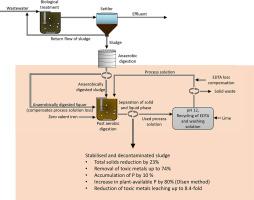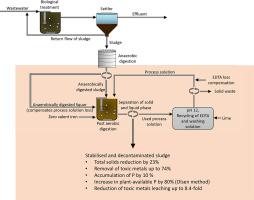同时好氧稳定的污水污泥和螯合剂辅助去除有毒金属在一个闭环过程
IF 12.4
1区 环境科学与生态学
Q1 ENGINEERING, ENVIRONMENTAL
引用次数: 0
摘要
污水污泥是磷的宝贵来源,但含有有毒金属,阻碍了它作为肥料的使用。我们提出了一种新的工艺,同时通过后有氧消化(12天,pH值5.8-7.6,固液比1:25(干w/v))稳定污泥,并使用乙二胺四乙酸酯(EDTA, 10 mM)去除有毒金属。用生石灰(CaO)将工艺溶液碱化至pH 12.5,平均可回收74.4%的EDTA,并在后续批次中重复使用。螯合剂的损失由Na-EDTA的加入弥补。有毒金属,以及过量的Ca和Na,有效地从回收的工艺溶液中去除,实现闭环操作,不产生废水。在连续5个批次中,污泥中固体总量平均减少23.2%,Zn、Cu、Cr和Pb的去除率分别为74%、61%、26%和43%。通过添加零价铁(干燥w/w为3%),稳定和净化后的污泥中残留有毒金属的浸出率进一步降低了55-88%。该工艺还将污泥中的磷浓度提高了15%,并将其植物利用度提高了1.8倍(通过乳酸铵萃取测定)。这个过程是可持续的:它保留了有价值的营养物质,可以整合到现有的污水处理厂操作中,只产生17%的固体废物(相对于污泥的干重),并且不产生废水。由于回收了昂贵的EDTA,试剂成本降低了一半,达到73欧元/吨的干污泥。本文章由计算机程序翻译,如有差异,请以英文原文为准。


Simultaneous aerobic stabilisation of sewage sludge and chelator-assisted removal of toxic metals in a closed-loop process
Sewage sludge is a valuable source of phosphorus but contains toxic metals that hinder its use as fertilizer. We present a novel process that simultaneously stabilises sludge through post-aerobic digestion (12 days, pH 5.8–7.6, solid-to-liquid ratio 1:25 (dry w/v)) and removes toxic metals using ethylenediaminetetraacetate (EDTA, 10 mM). On average, 74.4% of EDTA was successfully recycled by alkalinization of process solution with quicklime (CaO) to pH 12.5 and reused in subsequent batches. Chelator losses were compensated by the addition of Na-EDTA. Toxic metals, along with excess Ca and Na, were effectively removed from the recycled process solution, enabling closed-loop operation without wastewater generation. During five consecutive batches, total solids in the sludge were reduced by an average of 23.2%, and 74, 61, 26, and 43% of Zn, Cu, Cr, and Pb, respectively, were removed. The leaching of residual toxic metals from the stabilised and decontaminated sludge was further reduced by 55–88% through the addition of zero-valent iron (3% dry w/w). The process also increased the phosphorus concentration in the sludge by 15% and improved its phytoavailability up to 1.8-fold (as determined by ammonium-lactate extraction). This process is sustainable: it preserves valuable nutrients, can be integrated into existing wastewater treatment plant operations, generates only 17% solid waste (relative to the dry weight of the sludge), and produces no wastewater. Due to the recycling of costly EDTA, reagent costs were halved, reaching €73 t-1 of dry sludge.
求助全文
通过发布文献求助,成功后即可免费获取论文全文。
去求助
来源期刊

Water Research
环境科学-工程:环境
CiteScore
20.80
自引率
9.40%
发文量
1307
审稿时长
38 days
期刊介绍:
Water Research, along with its open access companion journal Water Research X, serves as a platform for publishing original research papers covering various aspects of the science and technology related to the anthropogenic water cycle, water quality, and its management worldwide. The audience targeted by the journal comprises biologists, chemical engineers, chemists, civil engineers, environmental engineers, limnologists, and microbiologists. The scope of the journal include:
•Treatment processes for water and wastewaters (municipal, agricultural, industrial, and on-site treatment), including resource recovery and residuals management;
•Urban hydrology including sewer systems, stormwater management, and green infrastructure;
•Drinking water treatment and distribution;
•Potable and non-potable water reuse;
•Sanitation, public health, and risk assessment;
•Anaerobic digestion, solid and hazardous waste management, including source characterization and the effects and control of leachates and gaseous emissions;
•Contaminants (chemical, microbial, anthropogenic particles such as nanoparticles or microplastics) and related water quality sensing, monitoring, fate, and assessment;
•Anthropogenic impacts on inland, tidal, coastal and urban waters, focusing on surface and ground waters, and point and non-point sources of pollution;
•Environmental restoration, linked to surface water, groundwater and groundwater remediation;
•Analysis of the interfaces between sediments and water, and between water and atmosphere, focusing specifically on anthropogenic impacts;
•Mathematical modelling, systems analysis, machine learning, and beneficial use of big data related to the anthropogenic water cycle;
•Socio-economic, policy, and regulations studies.
 求助内容:
求助内容: 应助结果提醒方式:
应助结果提醒方式:


